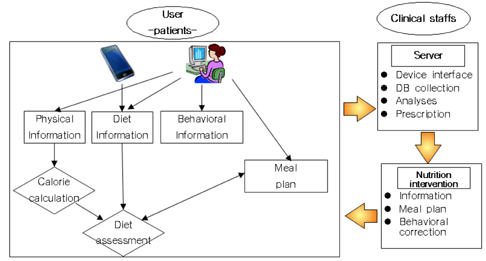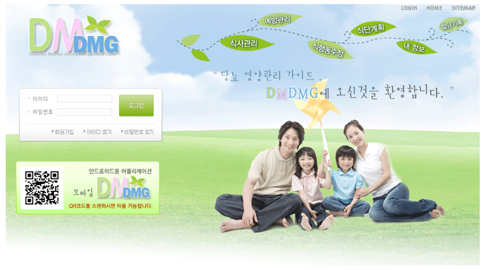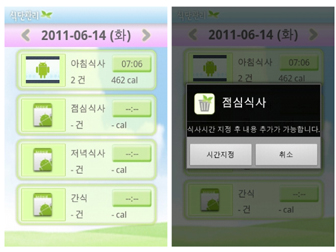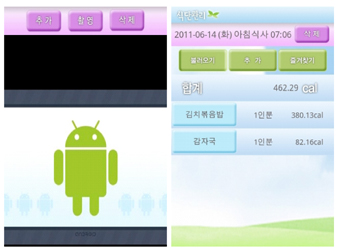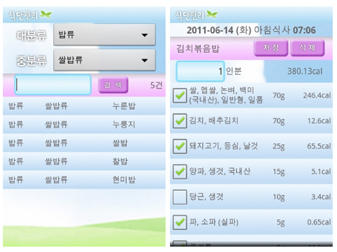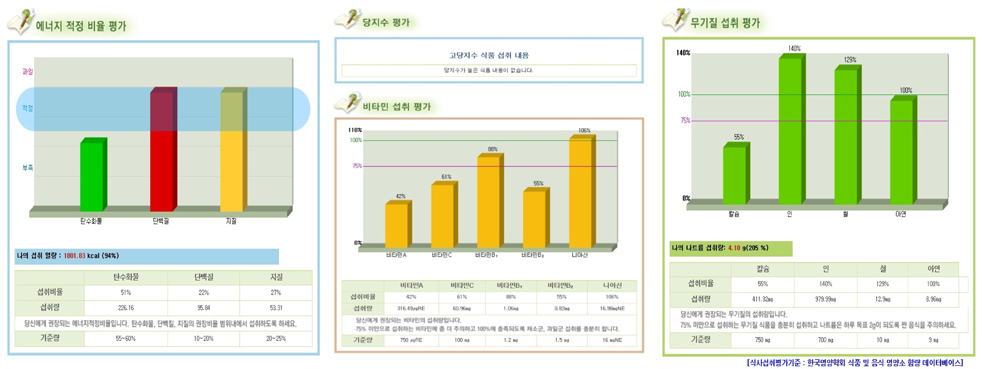Nutr Res Pract.
2016 Jun;10(3):342-351. 10.4162/nrp.2016.10.3.342.
The development of a mobile u-Health program and evaluation for self-diet management for diabetic patients
- Affiliations
-
- 1Department of Food Science and Nutrition, Seoul Women's University, Seoul 01797, Korea.
- 2Nutrition Team, Soonchunhyang University Hospital, Gyeonggi 14584, Korea.
- 3Department of Food Science and Nutrition, Soonchunhyang University, 22 Soonchunhyang-ro, Shinchang-myun, Asan, Chungnam 31538, Korea. hskim1@sch.ac.kr
- KMID: 2342138
- DOI: http://doi.org/10.4162/nrp.2016.10.3.342
Abstract
- BACKGROUND/OBJECTIVES
This study aims to develop a mobile nutritional management program for integration into the already developed web-based program, Diabetes Mellitus Dietary Management Guide (DMDMG) for diabetic patients. Further, we aim to evaluate the amended DMDMG program.
SUBJECTS/METHODS
The mobile application based on an Android operating system includes three parts: 1) record of diet intake, which allows users to take pictures of the meal and save to later add diet records into DMDMG; 2) an alarm system that rings at each meal time, which reminds users to input the data; 3) displays the diet record and the results of nutrient intake, which can be also viewed through the web program. All three parts are linked to the web-based program. A survey was conducted to evaluate the program in terms of nutrition knowledge, dietary attitude, eating behavior and diet intake by non-equivalent control group design among diabetic patients with 14 DMDMG users and 12 non-user controls after a one-month trial of DMDMG.
RESULTS
Non-users did not use the program, but participated in the weekly off-line nutrition classes for one month. The program users showed increased healthful dietary behavior (P < 0.01) and dietary attitude scores (P < 0.05). More DMDMG users had higher nutrition knowledge scores after one-month trial than non-users. However, dietary intake significantly increased in non-user group for calcium and sodium (P < 0.05) while the user group did not show significant changes.
CONCLUSIONS
The program has created positive changes in patients' dietary life. All the users were satisfied with the program, although some expressed minor difficulties with an unfamiliar mobile app.
Keyword
MeSH Terms
Figure
Cited by 1 articles
-
Self-management of Chronic Conditions Using mHealth Interventions in Korea: A Systematic Review
Jae Yoon Yi, Yujin Kim, Yoon-Min Cho, Hongsoo Kim
Healthc Inform Res. 2018;24(3):187-197. doi: 10.4258/hir.2018.24.3.187.
Reference
-
1. Sung YA. Prevention of type 2 diabetes. J Korean Med Assoc. 2000; 43:1103–1109.
Article2. Statistics Korea. Annual Report on the Cause of Death Statistics. Daejeon: Statistics Korea;2011.3. Stevens MJ, Feldman EL, Greene DA. The etiology of diabetic neuropathy. The combined roles of metabolic and vascular defects. Diabet Med. 1995; 12:566–579.
Article4. Medalie JH, Papier CM, Goldbourt U, Herman JB. Major factors in the development of diabetes mellitus in 10,000 men. Arch Intern Med. 1975; 135:811–817.
Article5. Par YS, Lee HK, Kim SY, Koh CS, Min HK, Lee CG, Ahn MY, Kim YI, Shin TS. Risk factors for non-insulin dependent diabetes mellitus. J Korean Diabetes Assoc. 1996; 20:14–24.6. Franz MJ, Horton ES Sr, Bantle JP, Beebe CA, Brunzell JD, Coulston AM, Henry RR, Hoogwerf BJ, Stacpoole PW. Nutrition principles for the management of diabetes and related complications. Diabetes Care. 1994; 17:490–518.
Article7. Nuttall FQ. Diet and the diabetic patient. Diabetes Care. 1983; 6:197–207.
Article8. The Diabetes Control and Complications Trial Research Group. The effect of intensive treatment of diabetes on the development and progression of long-term complications in insulin-dependent diabetes mellitus. N Engl J Med. 1993; 329:977–986.9. Kreuter M, Farrell D, Olevitch L, Brennan L. Tailoring Health Messages: Customizing Communication with Computer Technology. Mahwah (NJ): Lawrence Erlbaum Associates Inc.;2000.10. Witte K. Fishing for success: using the persuasive health message framework to generate effective campaign messages. In : Maibach E, Parrott RL, editors. Designing Health Messages: Approaches from Communication Theory and Public Health Practice. Thousand Oaks (CA): Sage Publications, Inc.;1995. p. 145–166.11. Skinner CS, Siegfried JC, Kegler MC, Strecher VJ. The potential of computers in patient education. Patient Educ Couns. 1993; 22:27–34.
Article12. Rollo ME, Ash S, Lyons-Wall P, Russell A. Trial of a mobile phone method for recording dietary intake in adults with type 2 diabetes: evaluation and implications for future applications. J Telemed Telecare. 2011; 17:318–323.
Article13. Park SY, Han JS. Effects of web-based nutrition counseling on nutrient intake and blood glucose in type II diabetic patients. J Korean Soc Food Sci Nutr. 2005; 34:1398–1406.
Article14. Kim HS. Effects of Web-based diabetic education in obese diabetic patients. J Korean Acad Nurs. 2005; 35:924–930.
Article15. Park SY, Han JS. Effects of web-based nutrition counseling on dietary behavior and food intake of type II diabetic patients. J Korean Soc Food Sci Nutr. 2006; 35:430–439.
Article16. Oh JA, Kim HS, Park MJ, Shim HS. Effects of Web-based health education on blood glucose and blood pressure improvement in postmenopausal women with impaired fasting blood glucose. J Korean Acad Nurs. 2011; 41:724–731.
Article17. Diem KG, Hino J, Martin D, Meisenbach T. Is extension ready to adopt technology for delivering programs and reaching new audiences? J Extension. 2011; 49:6FEA1.18. Sørensen C, Yoo Y, Lytinen K, Degross JI. Designing ubiquitous information environments: Socio-technical Issues and Challenges. New York (NY): Springer;2005.19. Brug J, van Assema P. Differences in use and impact of computer-tailored dietary fat-feedback according to stage of change and education. Appetite. 2000; 34:285–293.
Article20. Brug J, Campbell M, van Assema P. The application and impact of computer-generated personalized nutrition education: a review of the literature. Patient Educ Couns. 1999; 36:145–156.
Article21. Ahn Y, Bae J, Kim HS. Development of web-based u-Health self-nutrition management program for diabetic patients. Korean J Community Nutr. 2014; 19:372–385.
Article22. Ahn Y, Bae J, Youn JE, Kim HS. Needs assessment for web-based self-management program by the nutrition knowledge levels of diabetic patients. Korean J Community Nutr. 2011; 16:155–168.
Article23. Choe SJ, Park HR, Park DY, Ahn HS. A study on the sociopsychological factors influencing the dietary compliance of diabetics by using focus group interview. Korean J Community Nutr. 2000; 5:23–35.24. Kang HJ, Shin EM, Kim KW. Evaluation of nutrition education for diabetes mellitus management of older adults. Korean J Community Nutr. 2009; 14:734–745.25. Lim HS, Chyun JH, Kim YS, Nam MS. Effect of nutrition education on diabetic management in diabetic patients. Korean J Nutr. 2001; 34:69–78.26. Park DY, Choe SJ, Park HR, Ahn HS. A study on the sociopsychological factors influencing the dietary compliance of diabetics using questionnaire. Korean J Community Nutr. 2000; 5:36–49.27. Miller RL, Shinn M. Learning from communities: overcoming difficulties in dissemination of prevention and promotion efforts. Am J Community Psychol. 2005; 35:169–183.
Article28. Bodenheimer T, Lorig K, Holman H, Grumbach K. Patient self-management of chronic disease in primary care. JAMA. 2002; 288:2469–2475.
Article29. Glasgow RE, La Chance PA, Toobert DJ, Brown J, Hampson SE, Riddle MC. Long-term effects and costs of brief behavioural dietary intervention for patients with diabetes delivered from the medical office. Patient Educ Couns. 1997; 32:175–184.
Article30. Gillett M, Dallosso HM, Dixon S, Brennan A, Carey ME, Campbell MJ, Heller S, Khunti K, Skinner TC, Davies MJ. Delivering the diabetes education and self management for ongoing and newly diagnosed (DESMOND) programme for people with newly diagnosed type 2 diabetes: cost effectiveness analysis. BMJ. 2010; 341:c4093.
Article31. Steed L, Lankester J, Barnard M, Earle K, Hurel S, Newman S. Evaluation of the UCL diabetes self-management programme (UCL-DSMP): a randomized controlled trial. J Health Psychol. 2005; 10:261–276.
Article32. Chodosh J, Morton SC, Mojica W, Maglione M, Suttorp MJ, Hilton L, Rhodes S, Shekelle P. Meta-analysis: chronic disease self-management programs for older adults. Ann Intern Med. 2005; 143:427–438.
Article33. Lee Y, Lee M. Design of healthcare service system for diabetes patients using RFID. Proc Korean Inf Sci Soc Conf. 2006; 33:43–47.34. Collins LM, Baker TB, Mermelstein RJ, Piper ME, Jorenby DE, Smith SS, Christiansen BA, Schlam TR, Cook JW, Fiore MC. The multiphase optimization strategy for engineering effective tobacco use interventions. Ann Behav Med. 2011; 41:208–226.
Article35. Beasley JM, Riley WT, Davis A, Singh J. Evaluation of a PDA-based dietary assessment and intervention program: a randomized controlled trial. J Am Coll Nutr. 2008; 27:280–286.
Article36. Demiris G. Privacy and social implications of distinct sensing approaches to implementing smart homes for older adults. Conf Proc IEEE Eng Med Biol Soc. 2009; 2009:4311–4314.
Article37. Daugherty BL, Schap TE, Ettienne-Gittens R, Zhu FM, Bosch M, Delp EJ, Ebert DS, Kerr DA, Boushey CJ. Novel technologies for assessing dietary intake: evaluating the usability of a mobile telephone food record among adults and adolescents. J Med Internet Res. 2012; 14:e58.
Article38. Lieffers JR, Hanning RM. Dietary assessment and self-monitoring with nutrition applications for mobile devices. Can J Diet Pract Res. 2012; 73:e253–e260.
Article39. Rumpler WV, Kramer M, Rhodes DG, Moshfegh AJ, Paul DR. Identifying sources of reporting error using measured food intake. Eur J Clin Nutr. 2008; 62:544–552.
Article40. Poslusna K, Ruprich J, de Vries JH, Jakubikova M, van't Veer P. Misreporting of energy and micronutrient intake estimated by food records and 24 hour recalls, control and adjustment methods in practice. Br J Nutr. 2009; 101:Suppl 2. S73–S85.41. Beasley J, Riley WT, Jean-Mary J. Accuracy of a PDA-based dietary assessment program. Nutrition. 2005; 21:672–677.
Article
- Full Text Links
- Actions
-
Cited
- CITED
-
- Close
- Share
- Similar articles
-
- Application and evaluation of mobile nutrition management service for breast cancer patients
- Development of a mobile-based self-management health alarm program for obese children in South Korea and a test of its feasibility for metabolic outcomes: A study based on the information-motivation-behavioral skills model
- Development and Evaluation of Health Care Providers' Counseling Manual in Mobile Application for Lifelong Health Care among Patients with Chronic Hepatitis B
- Development of Web-based u-Health Self-nutrition Management Program for Diabetic Patients
- The Effect of a Diabetic Education Program on Self-care Behavior and Glucose Metabolism in Type 2 Diabetic Patients

